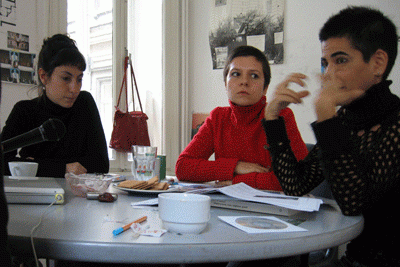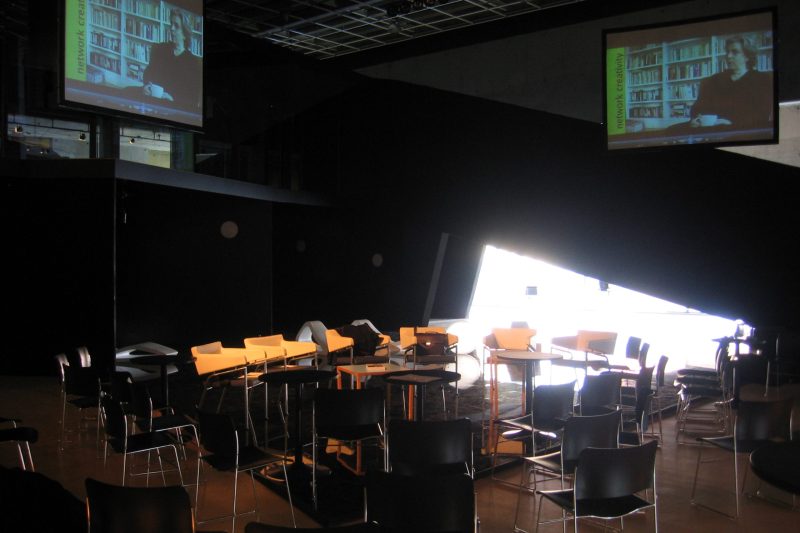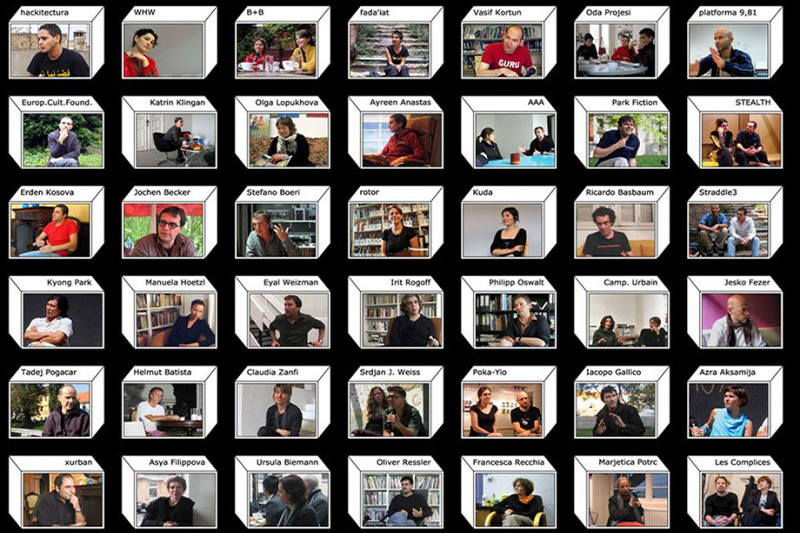- Interview
- Rotterdam
- 29.03.2006
- NETWORKED CULTURES
conversation with Ana Dzokic and Marc Neelen
Peter Mörtenböck/Helge Mooshammer: Marc and Ana, as members of STEALTH.unlimited you’re currently based in Rotterdam, but it seems that the city of Belgrade has also played a formative role for the group. What is the story behind this translocal trajectory?
Ana Dzokic: Indeed, it all started with Belgrade and the mid-1990s, when together with a few friends I initiated an independent association called Projekt X. We were all students of architecture at the time and in 1996 – a period of deep crisis in society – we organised an international event in an abandoned sugar factory, with 300 artists, architects and students. Through this project I began to realise that if you really want to make an impact and move things, a single person’s efforts aren’t enough. In 1998, Marc and I got interested in the transformation of the city of Belgrade and how, in less than a decade, a planned socialist society had turned into something completely new and difficult to describe. We started to collaborate with another colleague, Milica Topalovic, on a research project called Wild City. It focused on the massive, non-regulated development of an urban environment made by “ordinary” people but ignored or even condemned by professional architects. It all began as research at the Berlage Institute in Amsterdam. Being in the Netherlands, we found it intriguing to draw a comparison to the Dutch planning context, as well as to the ongoing debate on Vinex and Het Wilde Wonen (Wild Living) and its institutionalised plea for far-reaching deregulation of housing. To have an actual connection with Belgrade, we approached a friend of ours, Ivan Kucina, who was teaching at the Faculty of Architecture there. Wild City became much more than a thesis project. It shaped our way of thinking, our approach and created a context in which to operate.
PM/HM: There’s enormous interest in the “Belgrade phenomenon”. How do you spread the knowledge you acquired while working on your thesis and digging deeper into Belgrade’s situation? And how do you connect it all into an architectural discourse?
Ana Dzokic: One of the driving forces behind this project was to find out how to develop a collaborative approach and create a database on urban interventions by involving eighty students, while also having an influence on the discussion in Belgrade. The total discrepancy between the situation in Belgrade, where the whole system failed and control of spatial development was largely abandoned, and in the Netherlands, where each square centimetre of land is planned and given a function, became vital. What we find interesting is neither the one nor the other, but actually the situation in between. We’re not only interested in bottom-up developments and what people do, but in the interaction of institutions with what people do. Is there something that evolves when they interact consciously or subconsciously, something from which we can gain knowledge and that can be integrated into our profession? We’re not interested in cataloguing weird phenomena in order to exoticise issues existing in the Balkans, but to acquire knowledge from Belgrade’s “laboratory condition”. A challenging outcome of Wild City was that we became aware of the possibility of translating the urban (physical) complexity into the digital realm, of understanding and playing with the processes that shape the physical reality of the city, while at the same time getting to know the points where we might enter their trajectories in order to intervene. By connecting up with Mario Campanella, an aeronautics engineer with a master’s degree in artificial intelligence, we developed the next incarnation of the project. It was called ProcessMatter and resulted in a digital simulation of the practice of street trade as observed in Belgrade.
PM/HM: How do you relate your initial research in Belgrade with investigating the situation in cities like Rotterdam? Is this about enriching the Dutch model with the Belgrade experience – or is a certain change already happening here as well, because different groups of people are also introducing different ways of living to Rotterdam all the time?
Marc Neelen: I would say that looking at Belgrade tells us a lot about some phenomena that are actually happening right here in Rotterdam but aren’t so visible. In a crude situation like Belgrade’s socio-political, cultural, economic crisis, you find a lot of transitions occurring right in front of your eyes. Similar things are happening in the Netherlands, even if not so directly and they don’t affect your life as harshly – still they exist. In the project Europe Lost and Found, which we’ve been working on since 2005, the idea is to look at the former Yugoslav republics in order to have a better understanding of what is going on in the rest of Europe. Here in the Netherlands we’re also dealing with a state that is cutting its responsibilities and becoming less powerful. We used to have a fairly regulated planning procedure in Holland; roughly each decade the state released a plan on how the country should be transformed. This is one of the things that has been given up recently. What the effects of this will be isn’t at all clear and we’ve no similar local experiences from which to take reference – so this is where Belgrade may be able to give us vital clues. If we look at the ways of living in these two cities, Rotterdam is definitely much more diverse in culture than Belgrade, but it leaves little room for this diversity to express itself spatially.
PM/HM: This brings up the question of the architect’s role and possibilities in moulding future cityscapes. According to the traditional reading, the task of architecture is to come up with a certain spatial and visual configuration, one that is able to support a particular form of social organisation. Do you see ways for architecture to engage in social dynamics other than by concerning itself with aesthetic production?
Ana Dzokic: The preoccupation of architects with the aesthetic of built objects is something we don’t find very interesting. While researching on Belgrade, we weren’t fascinated by its do-it-yourself aesthetic, but by the logic of this urban transformation, how it worked, and how it responded to economic success or failure. Not every situation worked well – some were quite problematic, but others went far beyond our professional imagination.
Marc Neelen: For a while during Modernism, there was the idea that architects could have a monopoly on space and its aesthetics. This period is definitely over. Let’s speak about the situation in Europe. Control of who develops space is now distributed among many. Previously the state almost always set the conditions. In many countries today, the involvement of the state has decreased drastically and given way to private initiative, even on the lowest level of development, i.e. “do-it-yourself” interventions. If this is, indeed, the context we’re now dealing with, then things have gone far beyond aesthetics and are more about how you navigate developments in such conditions. To some extent you have to reinvent how you practise architecture. To be effective, you need to cooperate with others. One of the most important aspects of STEALTH’s work is the co-authoring of urban space. As the city is a product of a multitude of interactions, it’s important to tap into these energies – one single approach won’t work. Hence, working in a network is vital to our profession.
Ana Dzokic: One of the projects where this is being tested – and we’re sitting in it now during this interview – is the project Cut for Purpose, made on the invitation of the Museum Boijmans van Beuningen in Rotterdam. Three young curators from its City Editorial Board wanted to push their activities beyond the institution and bring the dynamics of the city into the museum: with the Rotterdam art scene and its city audiences. So we decided to install a grid of 2000 sheets of cardboard that would fill 400 square metres of museum space. Over a period of nine weeks and without any prearranged layout, a number of groups have been invited to excavate spaces for their activities within it. To set off the process, five simple spatial guidelines were provided. Here our tool has not been research, but the provision of a real physical structure as common ground – a “larger-than-human” tool for co-authoring.

Ana Dzokic and Marc Neelen have been working together since 1996. In 2000 they established STEALTH, a collective based in Rotterdam and Belgrade in which they have collaborated with Milica Topalovic, Ivan Kucina and Mario Campanella. STEALTH has established and participated in a number of projects on the complexity and inconsistency of the contemporary city, such as Wild City (Belgrade), Urban Catalyst (Amsterdam), Adaptations (Apexart, New York, and Fridericianum, Kassel), Challenging the Conservative Brain (Kunstverein Munich), Cut for Purpose (Museum Boijmans van Beuningen, Rotterdam) and Europe Lost and Found (Western Balkans). Ana and Marc are members of both the Centrala Foundation for Future Cities and the School of Missing Studies, an interdisciplinary network that engages in the experimental study of cities marked by abrupt transition.


